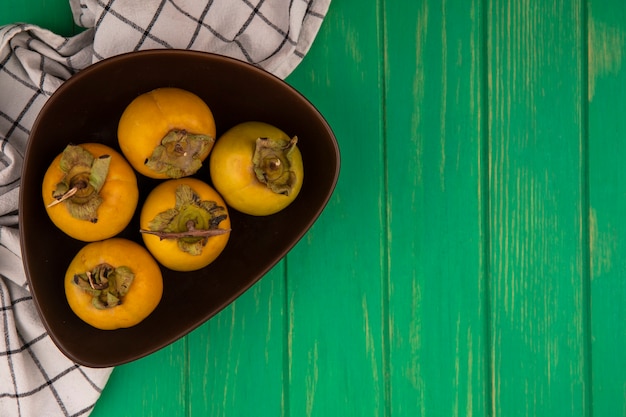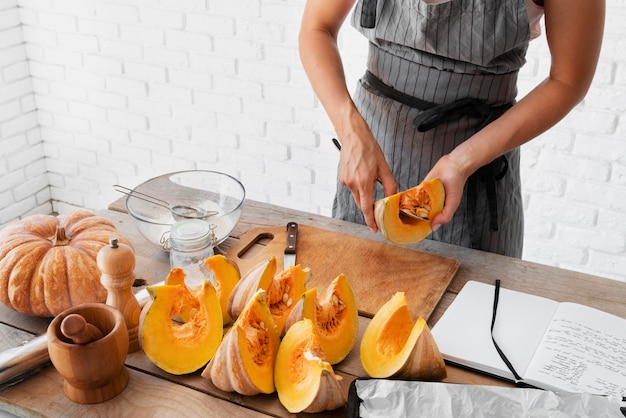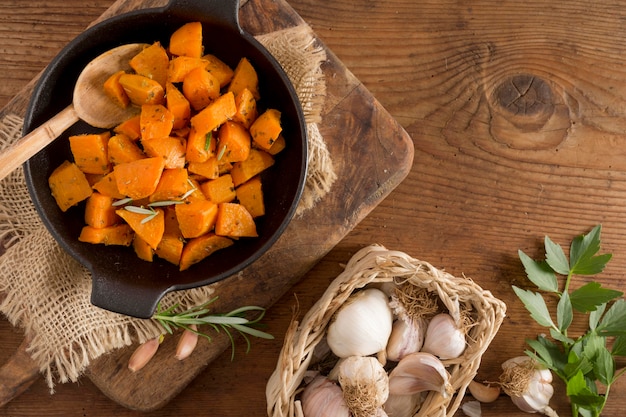Let's face it, there's nothing quite like the smell of roasted butternut squash filling the kitchen. It's just one of those comforting, autumnal scents that instantly evokes cozy nights in, a crackling fire, and a warm, hearty meal. For me, it’s always a sign that the cooler weather is on its way, and who doesn’t love a bit of comfort food when the days are getting shorter and the nights are drawing in?
Now, I know what you might be thinking – "Butternut squash? Isn't that just a bit boring?" Well, I’m here to tell you, it absolutely doesn’t have to be! It’s actually a ridiculously versatile vegetable, perfect for everything from warming soups and stews to gorgeous side dishes and even the most delicious desserts.
And the best part? It's ridiculously easy to cook. No fancy techniques or complicated recipes here. Just chuck it in the oven, and let it roast until it's soft and caramelised, and you're good to go.
So, whether you’re a seasoned cook or a complete novice in the kitchen, I'm here to guide you through a whole bunch of delicious and easy butternut squash recipes, perfect for all occasions. Buckle up, because we're about to get cooking!
(Part 1) Prepping the Squash: A Guide for the Uninitiated

Choosing the Right Squash
First things first, let's talk about choosing the right butternut squash. You want one that's firm to the touch, with a deep, vibrant orange colour. Avoid any squash that feels soft or has blemishes on the skin. You can even give it a little squeeze – it should feel quite heavy for its size.
Think of it like picking a good melon: you want it to feel weighty and solid, not squishy or light. A good butternut squash should also have a smooth, unbroken skin.
Preparing the Squash: A Step-by-Step Guide
Now, let's get down to business. First, you’ll need to cut off the top and bottom of the squash. Then, slice it lengthways, and use a spoon to scoop out the seeds. This is a good time to give those seeds a quick rinse and roast them for a tasty, crunchy snack.
Now, here’s where things get a bit trickier (but don’t worry, it’s totally manageable). You need to cut the squash into smaller pieces, about 2 inches thick. Now, this is where a good, sharp knife is your best friend.
Personally, I find it easier to peel the skin off the squash after I've chopped it. This way, you’re not wrestling with a slippery, oddly shaped squash while trying to peel it. But if you’re feeling brave (or just have a really good peeler), go ahead and peel it before you chop it up. Just be careful, those squash skins can be slippery!
(Part 2) Basic roasted butternut squash: A Simple Starting Point

This is the foundation for most butternut squash recipes. It's simple, it’s delicious, and it’s a great starting point for experimenting with flavours.
The Recipe
- 1 butternut squash, peeled, seeded and chopped
- 2 tablespoons olive oil
- 1 teaspoon salt
- 1/2 teaspoon black pepper
Instructions
- Preheat your oven to 200°C (400°F).
- Place the chopped squash on a baking sheet lined with parchment paper. This will prevent the squash from sticking and make for easier cleanup.
- Drizzle with olive oil, sprinkle with salt and pepper, and give it a good toss to coat everything evenly.
- Roast for 30-40 minutes, or until the squash is tender and slightly caramelised.
- You'll know it's ready when you can easily pierce it with a fork and the edges have a slightly golden, caramelized look.
(Part 3) Variations on a Theme: Flavourful Butternut squash dishes

Now, let’s add some flavour to our basic roasted butternut squash. Here are a few ideas to get you started:
Herbed Butternut Squash: A Burst of Freshness
Simply add a tablespoon of your favourite chopped herbs to the roasting pan. I love using a mix of rosemary, thyme, and sage, but you can experiment with anything you like. Think parsley, chives, oregano, even a sprinkle of basil.
The herbs will infuse the squash with a lovely aroma and a touch of freshness, adding a lovely complexity to the flavour.
Spiced Butternut Squash: Warm and Inviting
Add a pinch of your favourite spices to the squash before roasting. Cinnamon and nutmeg are classic choices, but you could also try ginger, cumin, or even a little cayenne pepper for a kick.
These spices add warmth and complexity to the squash. Cinnamon and nutmeg are particularly lovely with the sweetness of the squash, while ginger and cumin offer a more earthy, robust flavour.
Sweet and Savoury Butternut Squash: A Delicious Balance
For a sweet and savoury twist, drizzle a little maple syrup or honey over the squash before roasting. You could even add a handful of chopped pecans or walnuts for extra crunch.
The sweetness of the maple syrup or honey balances the inherent sweetness of the squash while adding a lovely caramelisation to the edges. The nuts add a bit of texture and richness.
Butternut Squash with Balsamic Glaze: A Crowd-Pleaser
This is a real crowd-pleaser. After roasting the squash, toss it with a tablespoon of balsamic vinegar and a teaspoon of brown sugar. Roast for another 5-10 minutes, until the glaze is sticky and glossy.
The balsamic vinegar adds a sharp, tangy counterpoint to the sweetness of the squash, and the brown sugar provides a rich, caramelised flavour.
(Part 4) Beyond the Basic: Butternut Squash in Main Courses
Now, let’s talk about incorporating butternut squash into our main courses. It’s not just for sides, you know!
Butternut squash soup: A Comforting Classic
This is a classic for a reason. It’s warming, comforting, and surprisingly easy to make.
The Recipe
- 1 butternut squash, peeled, seeded and chopped
- 1 onion, chopped
- 2 cloves garlic, minced
- 1 litre vegetable stock
- 1 tablespoon olive oil
- Salt and pepper to taste
Instructions
- Heat the olive oil in a large pot over medium heat.
- Add the onion and garlic, and cook for 5 minutes, until softened.
- Add the butternut squash, vegetable stock, salt and pepper. Bring to a boil, then reduce the heat to low and simmer for 20 minutes, or until the squash is tender.
- Use a hand blender to blend the soup until smooth.
- Serve warm with a dollop of cream or yogurt, and a sprinkle of fresh herbs.
butternut squash risotto: A Decadent Treat
This is a slightly more decadent option, but it's worth the extra effort. The sweetness of the butternut squash pairs beautifully with the creamy richness of the risotto.
You can find many recipes for butternut squash risotto online. The key is to use a good quality vegetable stock and to cook the risotto slowly, stirring frequently, until it's creamy and al dente.
(Part 5) Butternut Squash as a Starry Side Dish
You know what I love? Roasted butternut squash as a side dish. It’s so versatile, it goes with just about anything.
Butternut Squash with Maple-Glazed Chicken: A Sweet and Savoury Harmony
This is a classic pairing that never fails to impress. The sweet maple glaze complements the rich chicken beautifully, and the roasted butternut squash adds a touch of earthy sweetness.
This dish is both comforting and elegant, making it perfect for a family meal or a dinner party.
Butternut Squash and Sausage: A Hearty and Satisfying Duo
This is a hearty and satisfying combination, perfect for a cold winter’s day. The sweetness of the butternut squash balances the savoury sausage beautifully.
You can use any type of sausage you like – italian sausage, chorizo, or even a simple pork sausage will all work well.
Butternut Squash with Salmon: A Light and Healthy Option
This is a light and healthy option, perfect for a summer dinner. The roasted butternut squash adds a touch of sweetness to the delicate salmon.
You can bake the salmon and butternut squash together in the oven, or you can pan-fry the salmon and serve it over a bed of roasted butternut squash.
(Part 6) Butternut Squash Beyond Savoury: Sweet Treats
Now, for those who think butternut squash is only for savoury dishes, I have a little surprise for you. It’s actually amazing in sweet treats!
butternut squash bread: A Moist and Delicious Treat
This is a moist and delicious bread, perfect for a weekend brunch or afternoon snack. The butternut squash adds a subtle sweetness and a touch of moisture to the bread.
You can find many recipes for butternut squash bread online. It's a great way to use up leftover roasted butternut squash, and it's a healthy and satisfying alternative to regular bread.
butternut squash muffins: A Sneaky Way to Get Your Veggies
These are a great way to sneak some extra vegetables into your breakfast. They’re easy to make, and you can add all sorts of delicious variations, like chocolate chips, cranberries, or nuts.
Butternut squash muffins are a great way to start the day with a nutritious and delicious breakfast. They're also a great option for lunchboxes or for a quick snack.
butternut squash pie: A Seasonal Dessert Delight
This is a delicious and seasonal dessert. The butternut squash filling is creamy and smooth, and the pie crust is flaky and buttery.
Butternut squash pie is a classic autumn dessert that is sure to impress. It's also a great way to use up leftover roasted butternut squash.
(Part 7) Butternut Squash: A nutritional powerhouse
Okay, let's get real about this delicious orange squash. It's not just about flavour, it's a nutritional powerhouse, packed with vitamins, minerals, and antioxidants.
A Vitamin Bomb
Butternut squash is a great source of Vitamin A, which is crucial for healthy vision, skin, and immune function. You’ll also find Vitamin C, which is a powerful antioxidant that helps protect your cells from damage.
Mineral Rich
It's also a good source of potassium, which helps regulate blood pressure and muscle function. It's also rich in magnesium, which is important for bone health and muscle relaxation.
High in Fibre
And don't forget about fibre! Butternut squash is a good source of both soluble and insoluble fibre, which is important for digestion and maintaining a healthy gut.
(Part 8) Storing and Freezing Your Butternut Squash
Once you’ve got your hands on a beautiful butternut squash, you’ll want to make sure it lasts.
Storing
A whole, unpeeled butternut squash can be stored at room temperature for up to two weeks. If you've already peeled and chopped it, you can store it in an airtight container in the refrigerator for up to 3-4 days.
To keep your chopped butternut squash fresh, you can also store it in a bowl of cold water in the refrigerator. Change the water daily.
Freezing
To freeze your butternut squash, you need to blanch it first. This involves cooking it in boiling water for a few minutes, then immediately plunging it into ice water. This helps preserve its colour, flavour, and texture. Once blanched, you can freeze it in airtight containers for up to 6 months.
Freezing butternut squash is a great way to preserve it for later use. You can use it in soups, stews, or even smoothies.
(Part 9) Beyond the Basics: Some Tips for the Butternut Squash Enthusiast
Right, you've mastered the basics, now let's talk about taking your butternut squash game to the next level.
Get Creative: Experiment with Flavours
Experiment with different spices and herbs. The possibilities are endless! Don’t be afraid to try something new.
Think about what flavours you enjoy and try incorporating them into your butternut squash dishes. For example, if you love Indian food, try adding cumin, coriander, and turmeric to your roasted squash. Or, if you love Italian food, try adding oregano, basil, and garlic.
Don’t Overcook: Preserve Texture and Flavour
Overcooked butternut squash can become mushy and lose its flavour. Make sure you cook it just until it’s tender, but still has a little bit of bite.
If you're unsure if your butternut squash is cooked through, you can use a fork to test it. It should pierce through easily, but the squash should still have some firmness.
Roast it Low and Slow: For Even Cooking and Caramelization
Roasting at a lower temperature (around 180°C or 350°F) for a longer time can result in a more evenly cooked and caramelised squash.
This is a good technique if you're roasting a whole butternut squash. It will help to ensure that the squash cooks evenly and doesn't burn.
Try a Different Variety: Expand Your Squash Horizon
There are many other types of squash out there, like kabocha, delicata, and spaghetti squash. Give them a try!
Each type of squash has a unique flavour and texture. kabocha squash has a sweet, nutty flavour and a firm texture. delicata squash has a mild, sweet flavour and a delicate texture. Spaghetti squash, as its name suggests, has a stringy texture that resembles spaghetti.
(Part 10) FAQs: Everything You Need to Know
Alright, let’s address some of the most common questions about butternut squash.
1. What are the different ways to cook butternut squash?
You can roast it, bake it, steam it, boil it, or even grill it. It’s a pretty versatile vegetable.
Each method of cooking will result in a slightly different texture and flavour. Roasting is a popular method because it brings out the natural sweetness of the squash. Baking is a good option if you want a more tender squash. Steaming is a quick and healthy way to cook butternut squash. Boiling is a good option if you need to cook the squash quickly. Grilling gives the squash a nice smoky flavour.
2. Can I eat the skin of the butternut squash?
While it’s edible, it’s a bit tough and chewy. It’s best to peel the skin off before cooking.
The skin of the butternut squash is tough and fibrous, and it won't soften during cooking. It's best to peel it off before cooking, but you can also discard it after cooking.
3. How long does butternut squash take to cook?
roasting time varies depending on the size of the pieces, but typically it takes 30-40 minutes at 200°C (400°F).
You can check if the squash is done by piercing it with a fork. It should pierce through easily.
4. How do I know when butternut squash is done?
It should be tender and slightly caramelised. You can test it with a fork – it should pierce through easily.
If the squash is still firm to the touch, it needs to cook a little longer. If it's mushy, it's overcooked.
5. Can I freeze butternut squash?
Yes, you can. Just blanch it first by cooking it in boiling water for a few minutes, then plunging it into ice water. Then, freeze it in airtight containers for up to 6 months.
Blanching the butternut squash before freezing helps to preserve its colour, flavour, and texture.
(Part 11) Butternut Squash: More than Just a Vegetable
Look, it's more than just a vegetable. It's a flavourful, versatile ingredient that can elevate your dishes and add a touch of sweetness and colour to any meal. Whether you're a seasoned cook or a beginner in the kitchen, give butternut squash a try. You might just discover a new favourite food!
Beyond the recipes and nutritional benefits, there's a simple joy in working with butternut squash. The process of prepping it, the anticipation as it roasts in the oven, and the satisfaction of creating a delicious dish - it's a truly rewarding experience. So, don't be afraid to experiment, and enjoy the journey of cooking with butternut squash!
Everyone is watching

Corn on the Cob: The Ultimate Guide to Perfectly Cooked Ears
Healthy MealsAh, corn on the cob. Just the name evokes images of sunny days, barbecues, and that sweet, juicy flavour that ...

Perfect Pork Roast Oven Cooking Time: A Guide to Delicious Results
Healthy MealsThere's something truly satisfying about a perfectly roasted pork. The aroma alone is enough to make your mout...

Ham Cooking Time: How Long to Bake, Smoke, or Boil a Delicious Ham
Healthy MealsAh, ham. It's a classic, isn't it? A real crowd-pleaser, especially around holidays. And when done right, it'...

Scallops: The Ultimate Guide to Perfect Cooking
Healthy MealsAh, scallops. Those delicate, sweet, and utterly delicious morsels of the sea. They hold a special place in my...

Spaghetti Squash: The Ultimate Guide to Cooking and Serving
Healthy MealsRemember that time you saw spaghetti squash at the supermarket, looking all bumpy and strange, and thought, "W...
